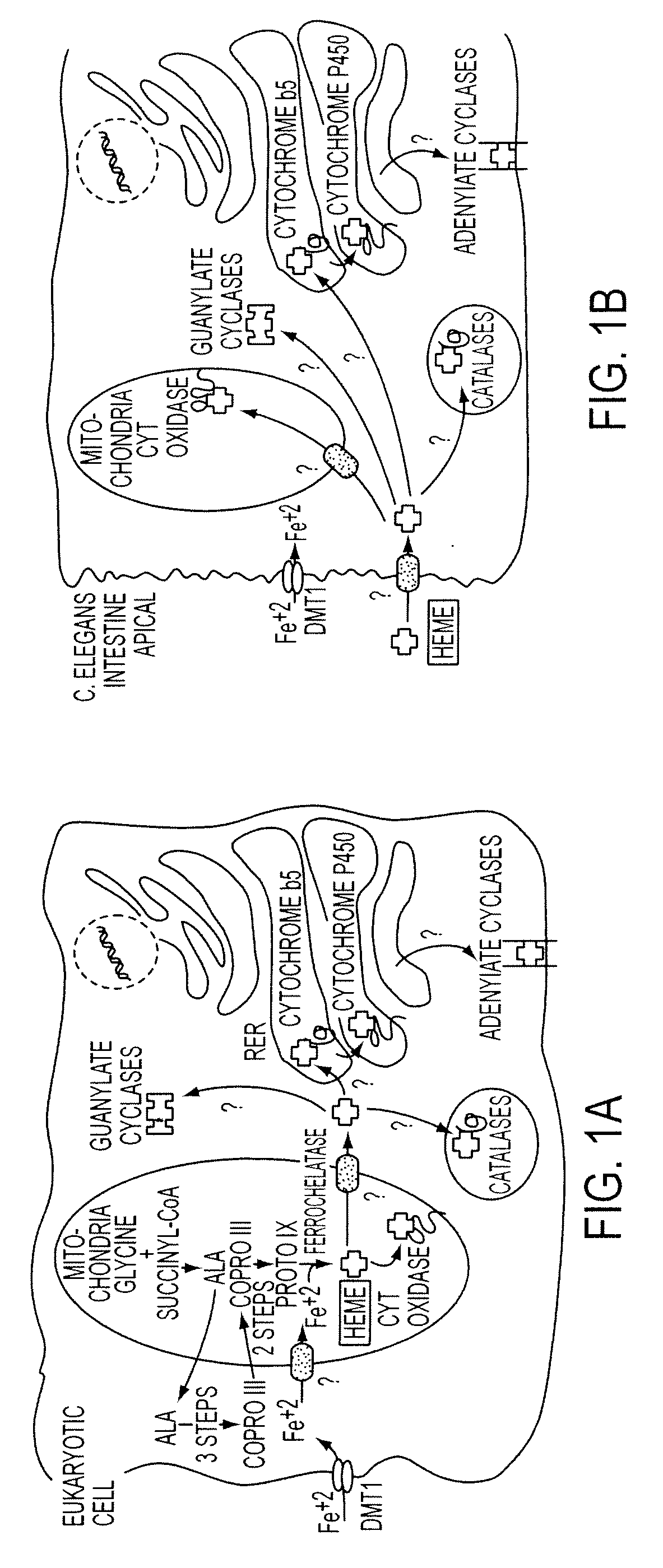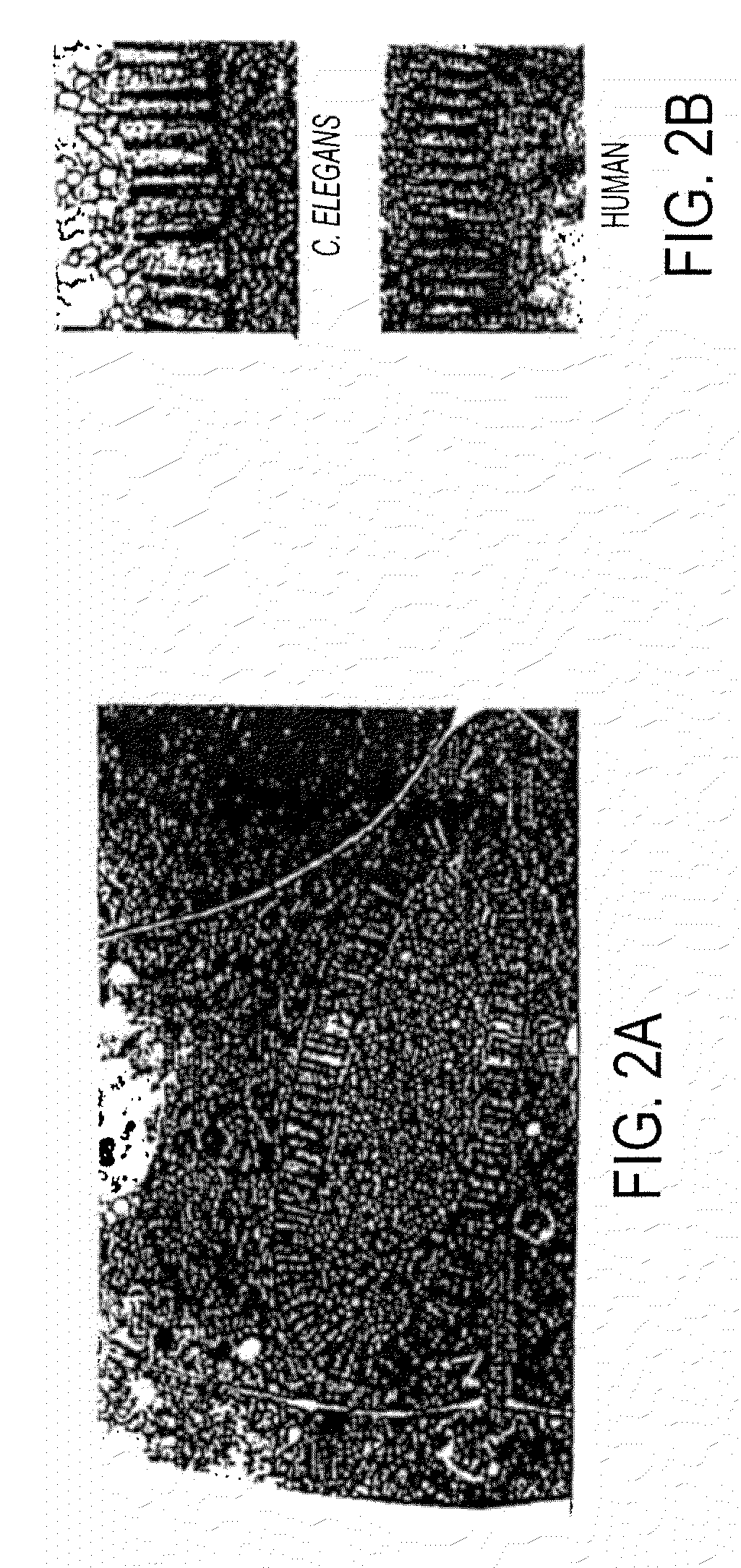Method of disrupting heme transport in nematodes and of modelling and evaluating eukaryotic heme transport
a technology of parasitic helminths and heme transport, which is applied in the field of disrupting heme transport in parasitic helminths, and a method of modelling and evaluating eukaryotic heme transport, can solve the problems of iron deficiencies in the environment, negatively affecting intelligence and cognition in children, and not easy to assimilate by mammals, so as to prevent helminthic infections in plants
- Summary
- Abstract
- Description
- Claims
- Application Information
AI Technical Summary
Benefits of technology
Problems solved by technology
Method used
Image
Examples
example 1
[0082]Synchronized wild-type N2 worms (˜300 late L4 larvae), grown aseptically in CeHR growth medium, are mutagenized with 50 mM ethyl methanesulfonic acid (EMS) (Sigma) for 4 h at 20° C. EMS is used because of its proven mutagenic ability, although, based upon our positive heme-based selection, a recently described transposon-based mutagenesis may also be used. The worms are washed three times with sterile M9 buffer and allowed to recover in CeHR medium at 15° C. for 12-15 h. Worms are analyzed microscopically to ensure normal morphology, and 30 mutagenized worms (P0S) will be transferred to each of the 8 separate T75 flasks (30×8=240 P0S) and allowed to lay eggs at 20° C. The worms are carefully monitored every day to check for viability and allowed go through two generations to yield L1 larvae in the F2 progeny (about 8-9 days). This yields approximately 300,000 F2 worms in each flask (30 P0×100 F1×100 F2=300,000) with ˜25% or 75,000 worms homozygous (m / m) for a mutation. Assumin...
example 2
[0097]As shown in FIG. 12, the basis of our F2 genetic screen was to identify mutants that survive and show normal growth and reproduction under high heme, because hemin concentrations of ≧800 μM results in growth arrest and lethality of wild-type worms (See FIG. 15). Synchronized wild-type N2 worms (˜6000 late L4 larvae), grown aspetically in CeHR growth medium, were mutagenized with 50 mM ethyl methanesulfonic acid (EMS) for 4 h at 20° C. (22). The worms were then washed three times with sterile M9 buffer and allowed to recover in CeHR medium at 15° C. for 12-15 h. These P0 worms were analyzed microscopically to ensure normal morphology, and 3000 mutagenized P0 worms were transferred to 10 separate T75 flasks (300×10=3000 P0) and allowed to lay eggs at 20° C. The worms were checked for viability and allowed to go through one generation to yield gravid F1 adults that are heterozygous for a mutation. The F1 gravid hermaphrodite worms were treated with bleach (1.1% bleach / 0.55 M NaOH...
example 3
Phenotypic Characterization C. elegans Mutants that are Disrupted in Heme Homeostatis
[0181]Although the pathways for heme transport and trafficking in mammals are unknown, specific proteins and regulatory mechanisms have been described in bacteria and yeast that govern the acquisition of heme from the environment, including proteins that mediate heme insertion into cytochrome c. These studies provide evidence that cytotoxic molecule such as heme does not merely diffuse through lipid bilayers within cells, but is actively assimilated. We, herein, provide a scheme for cellular heme homeostatis in eukaryotes whereby heme is translocated across biological membranes via specific transporters and subsequently trafficked to different cellular compartments by “heme chaperones” (FIG. 1A). Our studies with C. elegans suggest that this animal is unique because of its inability to make heme albeit requiring heme to survive. Thus, C. elegans provides an excellent eukaryotic paradigm to examine t...
PUM
| Property | Measurement | Unit |
|---|---|---|
| pH | aaaaa | aaaaa |
| pH | aaaaa | aaaaa |
| internal pressure | aaaaa | aaaaa |
Abstract
Description
Claims
Application Information
 Login to View More
Login to View More - R&D
- Intellectual Property
- Life Sciences
- Materials
- Tech Scout
- Unparalleled Data Quality
- Higher Quality Content
- 60% Fewer Hallucinations
Browse by: Latest US Patents, China's latest patents, Technical Efficacy Thesaurus, Application Domain, Technology Topic, Popular Technical Reports.
© 2025 PatSnap. All rights reserved.Legal|Privacy policy|Modern Slavery Act Transparency Statement|Sitemap|About US| Contact US: help@patsnap.com



